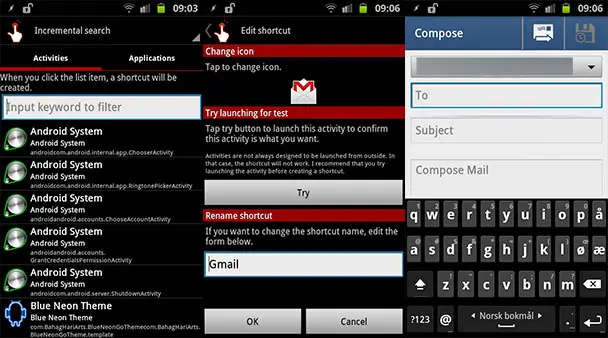QuickShortCutmaker lets you create shortcuts to things you didn’t know existed
 Most Android launchers allow you to access activities that come bundled with apps. These are basically shortcuts to features in the app, rather than the app itself. As an example, an activitiy can link to a playlist in a music player app instead of the entire app. What fewer (but still some) launchers allow you to do is use an app’s hidden intent (activity) as a shortcut. An intent is basically an app-level command that is used to trigger features within an app, or between apps. Think of it as a special command to make an app do something. These are normally hidden from the user, but actually available without any sort of root. Read on to see how to get access to these, and why you would want to.
Most Android launchers allow you to access activities that come bundled with apps. These are basically shortcuts to features in the app, rather than the app itself. As an example, an activitiy can link to a playlist in a music player app instead of the entire app. What fewer (but still some) launchers allow you to do is use an app’s hidden intent (activity) as a shortcut. An intent is basically an app-level command that is used to trigger features within an app, or between apps. Think of it as a special command to make an app do something. These are normally hidden from the user, but actually available without any sort of root. Read on to see how to get access to these, and why you would want to.
These so-called intents vary from app to app. Some apps do a lot of things using this system, others very little. As an example, my todo list app, Astrid, has an intent for opening the task edit screen.This intent is used by one of the app’s widgets to trigger the full task edit screen from a button in a pop-up box in the widget. This command doesn’t actually have to come from the widget though, and if you can find a way to trigger it yourself, you can basically enter the task edit screen directly without going through neither the widget nor the main app. Other examples include entering the search page of an app directly, opening the settings directly, and so on. Essentially these commands open parts of an app instead of the main app – as long as you can trigger them.
This is where QuickShortcutMaker comes in. It’s a free app that bridges the gap between normal activities that most launchers list and these hidden commands that fewer launchers list. It will list all the hidden commands it can find and then allow you to create shortcuts using them. That way you can add them to your home screen even if your launcher can’t get to them directly.
Not all of these commands will do anything though, some can cause force closes of apps, and there isn’t exactly a description of what they do. You might be able to guess from what they’re called, but it’s often a matter of trial and error. QuickShortcutMaker has a “try” button to allow you to do so before making the shortcut though, so it’s fairly painless. There are no guarantees that the feature you want to access directly will be available using such a command, but it doesn’t hurt to check.
This app also works great with AutoShortcut , a plugin for Tasker/Locale that allows those apps to trigger actions. QuickShortcutMaker and AutoShotcut working together gives Locale and Tasker access to triggering all those app commands without using the Send Intent feature in Tasker, which is more complicated to set up.
This might seem like too much hokey pokey to be worth it, but being able to directly open part of an app instead of the entire app can be more useful than you think.


